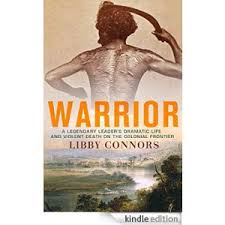
2015, 280 p.
If you, like many others, watched the ABC production of Kate Grenville’s The Secret River, then you should read this book. Think back to the silent, foreboding presence of indigenous people as they filed past the boundaries of what William Thornhill thought of as ‘his’ land, inscrutable, chilling, ethereal. There was a simple logic at play: settlers wanted the land and the aborigines wanted them gone. Kate Grenville complicates William Thornhill’s response and renders it explicable, even if it’s a response that we’d like to distance ourselves from. But beyond the defence of their country, the actions of the indigenous protagonists, in Grenville’s book and in settler reports of the time, remain fragmentary, apparently random and unknowable. Until now.
Libby Connor’s book Warrior challenges the simple classification of aboriginal ‘outrages’ as random, undisciplined and ultimately futile. Instead, she returns logic and agency to the indigenous tribal groupings in south-east Queensland during the pre-Separation days of the frontier. She does this through the story of Dundalli, a Dalla man who was executed in January 1855 for the murder of Andrew Gregor and his pregnant (white) house-servant Mary Shannon in an attack on the Caboolture River. White justice had taken twelve years to catch up with him. In the meantime, Dudalli had taken on mythic proportions by evading capture repeatedly, and his name became a byword for all ‘outrages’, whether he was involved or not. When he finally faced Supreme Court judge Roger Therry in a Brisbane circuit court hearing, in effect lawman-to-lawman, it was the judge who was intimidated by this tall, imposing leader, and not the other way round.
Libby Connors is a historian who has written a great deal on the interaction between British law and indigenous people. She is well placed to go through the evidence, the courtroom arguments, the legal principles and the punishment regimes of white settler justice. But the real achievement in her work is in fleshing out Dundalli, so that he is more than one of those silent wraiths of Grenville’s book. Drawing on the memories of a tribal man recorded as an oral history during the 1950s , she is able to reconstruct (albeit through extrapolation) the nature of a Dalla childhood and adolescence than Dundalli is likely to have experienced. Using documents generated by white missionaries, bureaucrats, settlers, anthropologists and historians, she gives Dundalli’s leadership a context by mapping out the intra-tribal politics and strategies utilized by different groups in what is now the Sunshine Coast/ Brisbane area. These politics were instrumental, pragmatic and fluid. One group might encourage the establishment of a mission on tribal land as a means to gain access to technology that ensured supremacy over other groups; another might consciously defer to white justice in order to fulfil the demands of their own indigenous justice. The British and Indigenous justice systems existed, and continued to exist, side by side, and she highlights that both systems of law were mutable and in tension with the other.
The book is beautifully written and imbued with a deep sense of place. A map that appears in the opening pages shows indigenous places superimposed onto familiar Western towns and rivers, highlighting the co-existence of two competing senses of ownership. Her frequent references to present-day Brisbane and Sunshine Coast landmarks would prick the consciousness of residents of those places, reminding them that another history runs alongside the sun, cosmopolitanism and tourism of both those places. When you find yourself overwhelmed by who’s who, and which group is which, you turn the page and there is a table; when you think ‘gee, a map would be handy here’, there it is. The text flows effortlessly, and the footnotes are unobtrusive, but when you look at them closely, you realize just how intricate and painstaking her construction of indigenous polity is.
This book has received the Queensland Premier’s Award for a work of State Significance, and I noticed that it was on the top of the list of recommended reading for Prime Minister Turnbull over his Christmas break issued by the Grattan Institute this year. It’s a tremendously important book. Many historians over the past forty years in particular have written, as Henry Reynolds does, of “the other side of the frontier” surveying the resistance of indigenous people to their dispossession across the frontier as a whole. What this book does is hone in on one particular location; one constellation of tribal groups; a set of named, individual leaders. It will make you pause the next time you read of an ‘aboriginal depredation’ in fiction, see it depicted in film or read it reported in settler testimony. It does what the fictional William Thornhill couldn’t, and white British justice wouldn’t do. It makes sense of what was perceived by settlers as brutish retaliation and gives it a legal, political and environmental logic, embedded in power structures negotiated and contested between intelligent, strategic and courageous leaders of men.

I’ve posted this review (the last for the year) to the Australian Women Writers Challenge website.

Pingback: Warrior, by Libby Connors | ANZ LitLovers LitBlog
thanks!
Excellent, this is the review I was waiting for, to link to from my own.
PS LOL I included Warrior in my Best-of-2015 list too, but perhaps The Great Saviour of Liberals at the Next Election might take more notice of the Grattan Institute? (When, when will the honeymoon end? Watching the news is like watching a romcom directed by someone who’s in love with the male lead…)
A really great review, Janine.
Thank you!
excellent, sensitive review. thank you
Thanks Trevor
Pingback: Australian Women Writers Challenge 2015 wrap up | The Resident Judge of Port Phillip
Pingback: November-December 2015 Roundup: Diversity | New Australian Women Writers Challenge Blog
Pingback: Six Degrees of Separation: From Wifedom to… | The Resident Judge of Port Phillip